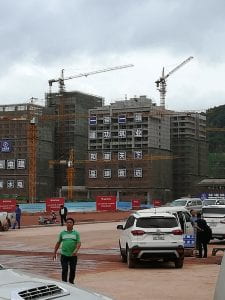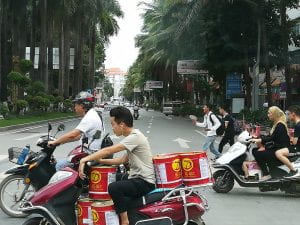Tourism is the main economic activity of Luangprabang province. Luang Prabang city itself is a UNESCO World Heritage Site[i] and attracts close to 10% of the total foreign visitorship to Laos[ii]. As such, it is useful for local Lao residents to speak the languages that tourists use: English, Korean and, increasingly, Chinese. This helps them get employment in tourism-related jobs, such as tour guiding, receptionists at tour companies, or service staff at hotels, guesthouses and restaurants.
Educational institutions offering Chinese or Korean languages to Lao students may be quite niche in Luangprabang. For example, a primary school offers Chinese language classes for interested students only during the summer vacation. Vacancies to study Chinese at the Confucius Institute of Souphanouvong University are also limited. This is probably because the Chinese are a relatively new, albeit increasingly huge, tourism demographic in Laos. English, being an international language, has so far served the Lao population well in communicating with Korean, European and other tourists.
Hence, within Luang Prabang city, several educational centres have been set up on the premise of offering better-quality English education to the local Lao youths. They also invite tourists or long-term visitors who are fluent in English to volunteer to teach English to the students, as this provides their students more opportunities to listen to English spoken by foreigners. English language centres include: ARDA Language Centre[iii], Sunrise Classroom[iv], Big Brother Mouse and Big Sister Mouse[v].
However, while there are ample opportunities for learning English in the city, opportunities are limited in rural villages. Lao children do not learn English until they reach secondary school (though they do have an enriching curriculum or Lao language, mathematics, the sciences, etc.). When Lao children start to learn English in secondary school (which is several kilometres away for some villages), English classes are typically about one hour a week. For Thapene village and the villages near to Kuang Si waterfall, an iconic tourist destination for tourists visiting Luang Prabang, this puts youths at a disadvantage as they are unable to communicate with the tourists passing through their village. Moreover, they will also find it difficult to find jobs at the tourism sites (e.g. The Living Land Company[vi], Luang Prabang Elephant Camp[vii], Laos Buffalo Dairy[viii], Kuang Si Rafting[ix], Butterfly Park[x]) set up along the road to Kuang Si waterfall.
In 2018, Mr Sai stepped in to fill this gap. Originally from Chomphet district, he moved to Thapene village after 6 years working for Luang Prabang’s Traditional Arts & Ethnology Centre (TAEC)[xi] to live with his wife and children. Having a college certificate in English, he started teaching his children English in addition to coaching them on their primary school subjects. Word spread around the village, and his children’s friends started to join his classes. His work experience at the TAEC also gave him the idea of setting up Fasay Garden[xii], a homestay experience where tourists can experience local culture, Lao food, and volunteer to help him with the English classes. Today, he offers classes to children from his village and neighbouring villages (as far as 8km away) at almost no fees. Children who attend his classes range from 6 to 16 years old. Because some of his students help their parents with family-run businesses servicing the tourism industry (e.g. restaurants, gift shops), his classes are early in the morning (~7-9am) or in the early-evening (~5-7pm) – before and after work hours. Concurrently, Mr Sai uses his family’s land for an organic garden to teach his students about traditional local games as well as planting fruits, herbs and vegetables. The latter is a useful self-subsistent skill that should be retained despite many families’ transition from agriculture to tourism-related jobs in the past 10-20 years.
Here is a video of Mr Sai introducing what he does in Thapene village:
As is typical of rural-urban migrations, most people from the countryside would want to settle in the city for better-paying jobs and the conveniences of city life. Mr Sai’s story is unique in that he has, instead, moved back to the countryside with the serendipitous mission of giving rural children a leg-up through English language tutoring. This is whilst keeping them connected to traditional games and gardening (important for environmental know-how) amidst the backdrop of their villages transiting towards a more tourism-dependent economy.
===========
[i] http://whc.unesco.org/en/list/479
[ii] In 2018, Luangprabang province received 576,610 foreign visitors, out of the total 6, 553,315 foreigners who visited Laos. Source: Tourism Research Division, Tourism Development Department, Ministry of Information, Culture and Tourism, ‘Statistical Report on Tourism in Laos, 2018’, available at: http://tourismlaos.org/files/files/Statistical%20Report%20on%20Tourism%20in%20Laos/ACKNOWLEDGEMENT%2020184-update.pdf (accessed 30 July 2019)
[iii] http://www.ardalaos.com/
[iv] https://www.facebook.com/sunrise.classroom
[v] http://www.bigbrothermouse.com/volunteer.html
[vi] http://www.livinglandlao.org/
[vii] http://www.luangprabangelephantcamp.com/
[viii] http://www.laosbuffalodairy.com/
[ix] https://www.facebook.com/Luang-Prabang-Kuang-Si-Rafting-%E8%A7%82%E6%BA%AA%E6%BC%82%E6%B5%81-%E0%BA%A5%E0%BB%88%E0%BA%AD%E0%BA%87%E0%BB%80%E0%BA%AE%E0%BA%B7%E0%BA%AD%E0%BA%AB%E0%BB%89%E0%BA%A7%E0%BA%8D%E0%BA%8A%E0%BA%B5-379812915906080/
[x] http://tourismluangprabang.org/things-to-do/nature/kuang-si-butterfly-park/












Recent Comments